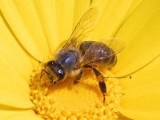
Apoidea
Encyclopedia
The superfamily Apoidea is a major group within the Hymenoptera
, which includes two traditionally-recognized lineages, the "sphecoid
" wasp
s, and the bee
s, who appear to be their descendants.
wasps that switched to the use of pollen
and nectar as larva
l food, rather than insect
prey; this presumably makes Crabronidae a paraphyletic group. Accordingly, bees and sphecoids are now all grouped together in a single superfamily, and the older available name is "Apoidea" rather than "Sphecoidea" (which, like Spheciformes
, has been used in the past, but also defined a paraphyletic group and has been abandoned).
As the bees themselves (not including their wasp ancestors) are still considered a monophyletic group, it is still convenient to use a grouping between superfamily and family to unify all bees. A few recent classifications have addressed this problem by lumping all bee families together into a single large family Apidae
, though this has not met with widespread acceptance. The alternative classification in more common use is to unite all bees under the name Anthophila
(Engel, 2005), which is equivalent to the obsolete name Apiformes (which meant bee-like forms in Latin
).
Hymenoptera
Hymenoptera is one of the largest orders of insects, comprising the sawflies, wasps, bees and ants. There are over 130,000 recognized species, with many more remaining to be described. The name refers to the heavy wings of the insects, and is derived from the Ancient Greek ὑμήν : membrane and...
, which includes two traditionally-recognized lineages, the "sphecoid
Sphecidae
Sphecidae is a cosmopolitan family of wasps that include digger wasps, mud daubers and other familiar types that all fall under the category of thread-waisted wasps.The are predominently solitary wasp,distributed world wide.At present this family consist of eight subfamilies and three tribes...
" wasp
Wasp
The term wasp is typically defined as any insect of the order Hymenoptera and suborder Apocrita that is neither a bee nor an ant. Almost every pest insect species has at least one wasp species that preys upon it or parasitizes it, making wasps critically important in natural control of their...
s, and the bee
Bee
Bees are flying insects closely related to wasps and ants, and are known for their role in pollination and for producing honey and beeswax. Bees are a monophyletic lineage within the superfamily Apoidea, presently classified by the unranked taxon name Anthophila...
s, who appear to be their descendants.
Nomenclature
Bees appear in recent classifications to be a specialized lineage of crabronidCrabronidae
Crabronidae is a large family of wasps, that includes nearly all of the species formerly comprising the now-defunct superfamily Sphecoidea. It collectively includes well over 200 genera, containing well over 9000 species. Crabronids were originally a part of Sphecidae, but the latter name is now...
wasps that switched to the use of pollen
Pollen
Pollen is a fine to coarse powder containing the microgametophytes of seed plants, which produce the male gametes . Pollen grains have a hard coat that protects the sperm cells during the process of their movement from the stamens to the pistil of flowering plants or from the male cone to the...
and nectar as larva
Larva
A larva is a distinct juvenile form many animals undergo before metamorphosis into adults. Animals with indirect development such as insects, amphibians, or cnidarians typically have a larval phase of their life cycle...
l food, rather than insect
Insect
Insects are a class of living creatures within the arthropods that have a chitinous exoskeleton, a three-part body , three pairs of jointed legs, compound eyes, and two antennae...
prey; this presumably makes Crabronidae a paraphyletic group. Accordingly, bees and sphecoids are now all grouped together in a single superfamily, and the older available name is "Apoidea" rather than "Sphecoidea" (which, like Spheciformes
Spheciformes
The Spheciformes is a paraphyletic assemblage of insect families which collectively comprise the "sphecoid wasps"; these are all the members of the superfamily Apoidea which are not bees, and in older classifications were called the "Sphecoidea"...
, has been used in the past, but also defined a paraphyletic group and has been abandoned).
As the bees themselves (not including their wasp ancestors) are still considered a monophyletic group, it is still convenient to use a grouping between superfamily and family to unify all bees. A few recent classifications have addressed this problem by lumping all bee families together into a single large family Apidae
Apidae
The Apidae are a large family of bees, comprising the common honey bees, stingless bees , carpenter bees, orchid bees, cuckoo bees, bumblebees, and various other less well-known groups...
, though this has not met with widespread acceptance. The alternative classification in more common use is to unite all bees under the name Anthophila
Bee
Bees are flying insects closely related to wasps and ants, and are known for their role in pollination and for producing honey and beeswax. Bees are a monophyletic lineage within the superfamily Apoidea, presently classified by the unranked taxon name Anthophila...
(Engel, 2005), which is equivalent to the obsolete name Apiformes (which meant bee-like forms in Latin
Latin
Latin is an Italic language originally spoken in Latium and Ancient Rome. It, along with most European languages, is a descendant of the ancient Proto-Indo-European language. Although it is considered a dead language, a number of scholars and members of the Christian clergy speak it fluently, and...
).
External links
- All Living Things Images, identification guides, and maps of Apoidea.
- Solitary Bees Popular introduction to the Hymenoptera Apoidea.
- Fiori e Api d'Albore and Intoppa Flower visiting bees in Europe pdf. In Italian but excellent table with Latin names.
- Native Bees of North America

